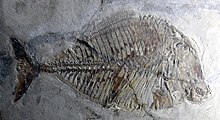| Pycnodus Temporal range: Ypresian PreꞒ Ꞓ O S D C P T J K Pg N Teeth assigned to Pycnodus date back to Kimmeridgian, see text | |
|---|---|

| |
| Pycnodus apodus (=P. platessus) | |
| Scientific classification | |
| Domain: | Eukaryota |
| Kingdom: | Animalia |
| Phylum: | Chordata |
| Class: | Actinopterygii |
| Order: | †Pycnodontiformes |
| Family: | †Pycnodontidae |
| Subfamily: | †Pycnodontinae |
| Genus: | †Pycnodus Agassiz, 1833 |
| Type species | |
| Pycnodus apodus Volta, 1796 | |
| Synonyms | |
|
Coryphaena apoda Volta, 1796 | |
Pycnodus (from Greek: πυκνός puknós, 'dense' and Greek: ὀδούς odoús 'tooth') is an extinct genus of ray-finned fish from the Eocene period. It is wastebasket taxon, although many fossils from Jurassic or Cretaceous are assigned to this genus, only Eocene species, P. apodus is valid. As its name suggests, it is the type genus of Pycnodontiformes.

The known whole fossils of Pycnodus are up to 30.6 centimetres (10 in) long, and have a superficial resemblance to angelfish or butterflyfish. The animals, as typical of all other pycnodontids, had many knob-like teeth, forming pavements in the jaws with which to break and crush hard food substances, probably mollusks and echinoderms. These teeth are the most common form of fossil.
Valid species of Pycnodus is only known from Monte Bolca Lagerstätte in Italy, however fossils that were assigned to Pycnodus have been found in present-day India, North Africa, Belgium, England, regions corresponding with the Tethys Ocean. A specimen of the prehistoric whale, Basilosaurus isis, was found in the Eocene-aged Wadi El Hitan with stomach contents of its last meals, including a large specimen of the species P. mokattamensis along with skeletons of a smaller whale called Dorudon.
References
- ^ Poyato-Ariza, Francisco José (2013-02-01). "Sylvienodus, a new replacement genus for the Cretaceous pycnodontiform fish "Pycnodus" laveirensis". Comptes Rendus Palevol. 12 (2): 91–100. Bibcode:2013CRPal..12...91P. doi:10.1016/j.crpv.2013.01.001. ISSN 1631-0683.
- ^ Cawley, John Joseph; Marramà, Giuseppe; Carnevale, Giorgio; Kriwet, Jürgen (2018-05-18). "A quantitative approach to determine the taxonomic identity and ontogeny of the pycnodontiform fish Pycnodus (Neopterygii, Actinopterygii) from the Eocene of Bolca Lagerstätte, Italy". PeerJ. 6: e4809. doi:10.7717/peerj.4809. ISSN 2167-8359. PMC 5961631. PMID 29796348. S2CID 43924767.
- Ebert, Martin (2013). "The Pycnodontidae (Actinopterygii) in the late Jurassic: 1) The genus Proscinetes GISTEL, 1848 in the Solnhofen Archipelago (Germany) and Cerin (France)".
{{cite journal}}: Cite journal requires|journal=(help) - Mohabey, D. M.; Udhoji, S. G. (May 1996). "Pycnodus lametae (Pycnodontidae), a Holostean Fish from Freshwater Upper Cretaceous Lameta Formation of Maharashtra". Geological Society of India. 47 (5): 593–598.
- Voss, Manja; Antar, Mohammed Sameh M.; Zalmout, Iyad S.; Gingerich, Philip D. (2019). "Stomach contents of the archaeocete Basilosaurus isis: Apex predator in oceans of the late Eocene". PLOS ONE. 14 (1): e0209021. Bibcode:2019PLoSO..1409021V. doi:10.1371/journal.pone.0209021. PMC 6326415. PMID 30625131.
| Taxon identifiers | |
|---|---|
| Pycnodus | |
This article about a prehistoric ray-finned fish is a stub. You can help Misplaced Pages by expanding it. |
